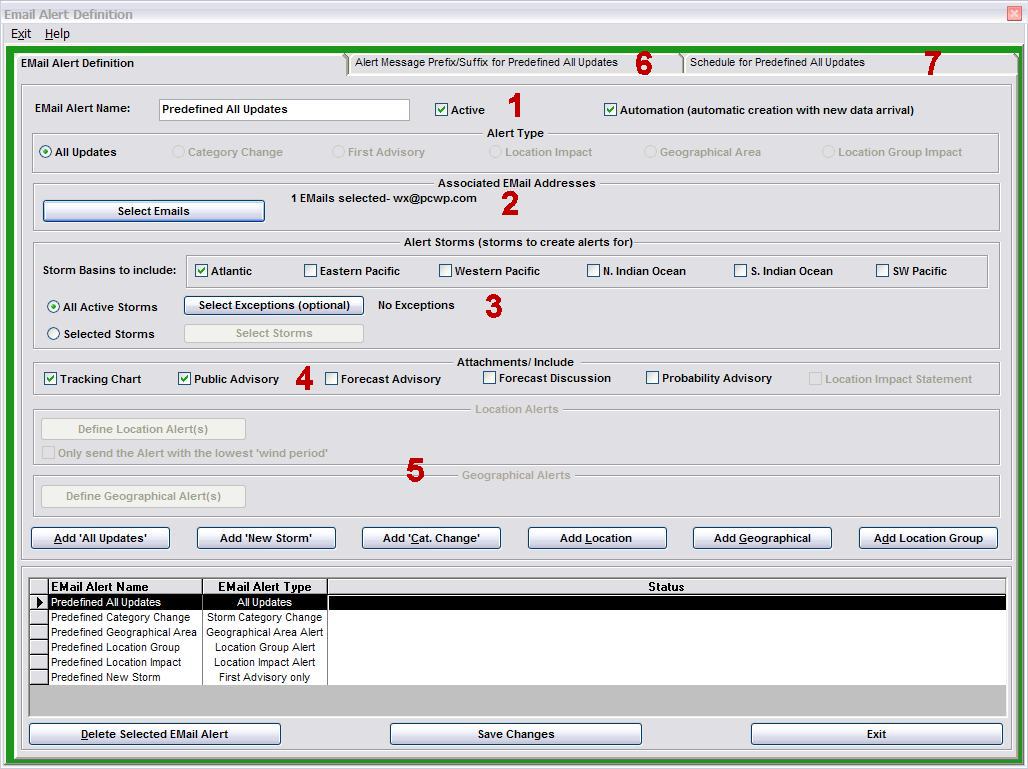
EMail Alert Setup
An excellent video describing EMail ALerts and their setup can be found at http://www.storminfo.net/trainingvideo/2011u/EMA/EMA.html .
The setup of
automated Email Alerts can be selected via the Tools menu option or via the Command
Bar Icons.
A dialog screen
is displayed showing all of the current Email Alerts.
The system comes predefined with one of each type.
Important: There are 2 pre-requirements to successfully Email these Alerts.
1.
You
need to have setup your Email via the User Preferences Option (EMAIL Setup).
2.
You
must define the email addresses or groups you would like to send these reports to…
via the User Preferences (Email Addressbook). This
is required even if you have selected the Outlook method for emailing in the Email
setup.
There
are 6 types of automatic Email Alerts…
All updates, New Storm, Category Change, Location, Location Group, Geographical Area.
More information on Email Alerts (including examples)
The following
section will discuss the setup of each type of alert as well as discussing the “error
catching” feature of the setup option. Please
note that the definition of Automatic Summary Reports and “Other” Automations
have a similar look and feel.
The Automated
Email Alert Setup screen looks similar to the following.

Section
1, 2, 3, 4, Tabs 6 and 7 are essentially the same for all 6 types of Email Alerts.
Section 5 is the only section that varies by type of Alert.
Section
1 indicates the Name
of the Alert as well as indicators that control whether this alert is active
and also whether it should be automatically
generated. It is valid to have an alert
that is active with the automatic option turned off.
This is typically used when you only want to generate the Alert manually…
i.e. selected from the Hurrtrak menu.
Please note, you cannot manually generate the New Storm or Change Category
Alert. It can only be generated from the automated
processes (i.e. when new storm data is received).
Section
2 defines the email address(s)
or email groups that you would like to send this type of Alert to.
Remember you need to define these emails or group to the Hurrtrak system via
the User Preferences / Email addressbook option.
Obviously at least one email address must be selected for this alert to be
defined correctly.
Section
3 defines the storms
you would like considered when running the alert.
The “all active storms”
selection will select only storms that are currently having advisories issued for
them. When you manually run the alert, it
will only include storms that have data no more than 18 hours old (the “age”
setting can be changed in the user options). With
this option you can specify storms to “ignore” via the Select
Exceptions command.
The “Selected
Storms” option will run the alert for only storms you manually select.
You can select those storms via the Select
Storms command.
Finally, Global/Advanced
users can select or de-select the storm basins
they want to include for storm selection. i.e.
if you are only interested in the Atlantic and Western Pacific then check only those
2 items.
Note: The New
Storm Alert does not consider the Storm Selection criteria.
i.e. There is no point of having to define the new storms before they occur.
It does consider the basins selected as it will only report on new storms
in the basins you have selected.
Section
4 defines which additional
information and attachments you would like to include with this alert.
Note, the Location Impact Statement is only available for Location Group Alerts.
Section/Tab
6 defines additional
text you would like included within the email body of the Alert.
This is optional. See example below.
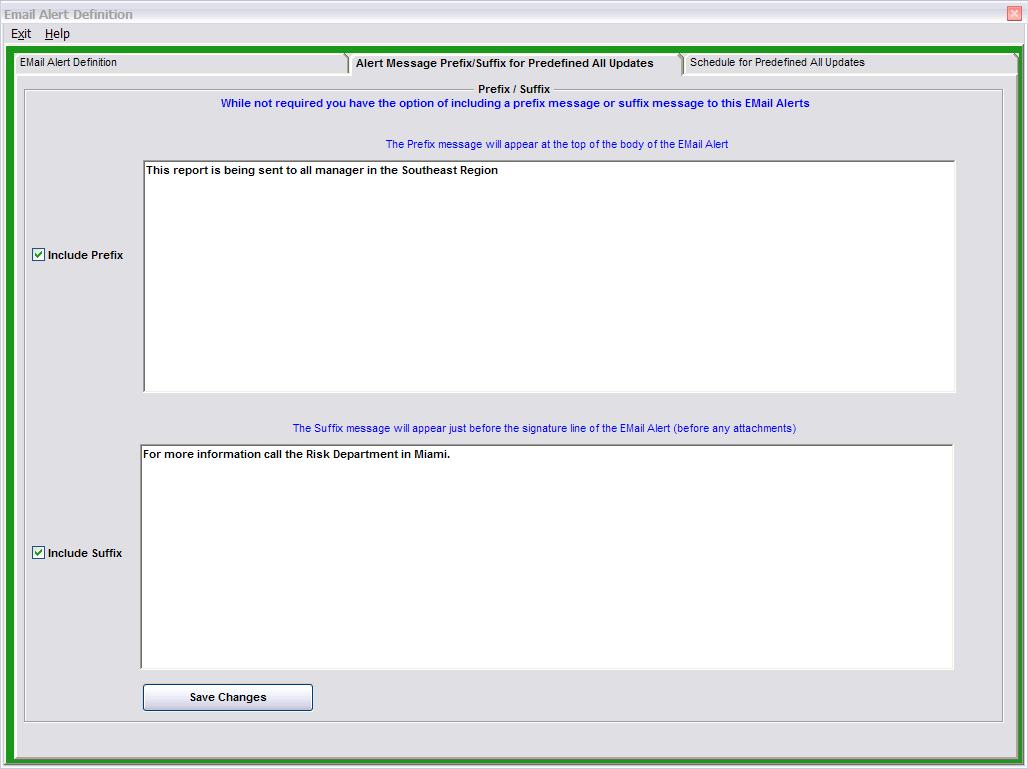
Section/Tab
7 allows the user to
adjust the schedule of when this alert can automatically be run.
In this way you can create Email alerts only on certain days and times.
See example below.
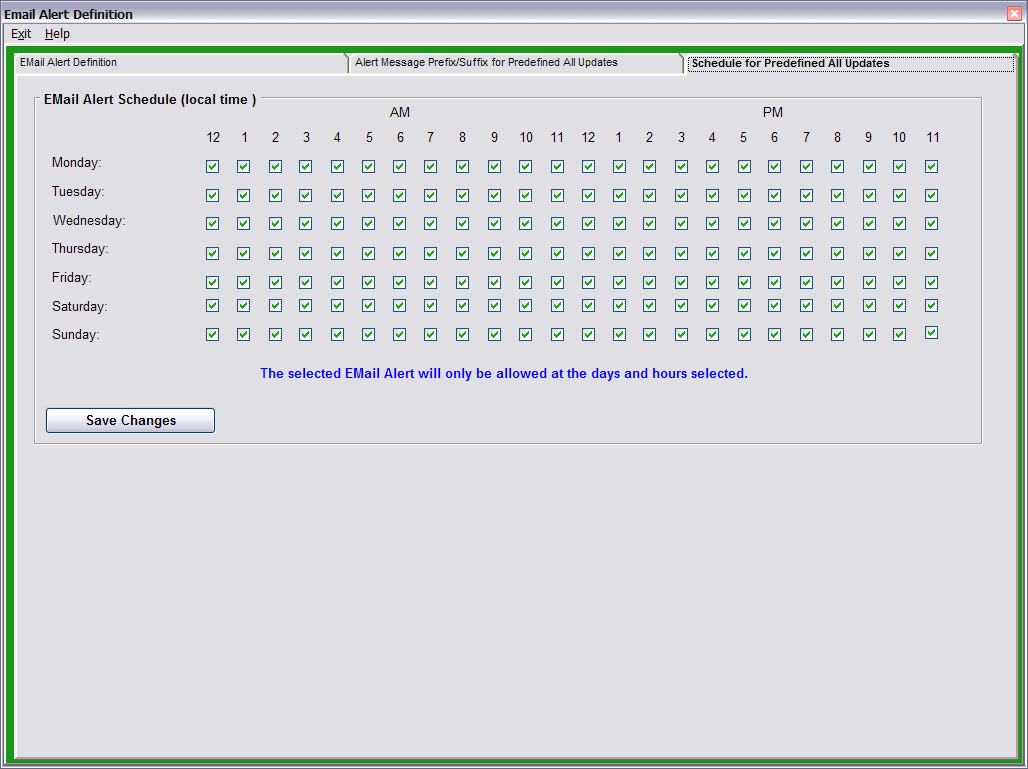
Now
let’s look at the one section DOES vary by Automated Email Alert
TYPE.
Section
5 is information that
is specific to the Alert type being defined.
For the ALL
Update, Category Change and New Storm Alerts, this section is disabled…
i.e. no additional information is needed.
For the Location
Alert, this section appears like the image below.

You can define
several locations for each Location Alert. The
dialog box for doing so is shown below…
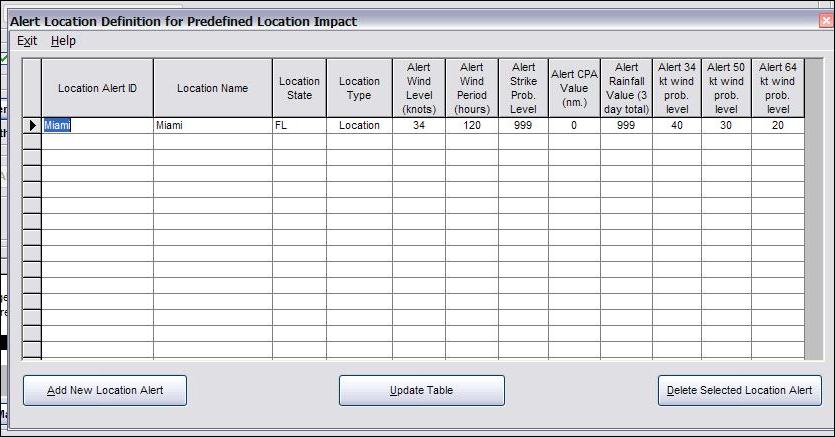
Click here for more information on this dialog box
To add
locations, select the Add New Location and answer the questions on the setup
“wizard”. If you select multiple
locations for the Location Alert, an separate email will be sent for each one to
each Email address you defined (assuming the trigger has been met for the location).
i.e. if you have 5 locations defined but only 1 is expected to be impacted
(triggered), then only 1 Email will be sent. There
is one special case related to this we will discuss at the end of this section.
Note: There is absolutely no problem
with defining only one location per Location Alert.. It may, in fact, simplify things
a bit.
As mentioned
earlier, the criteria available for location alerts are Wind speed, Timing of wind,
Rainfall, Wind probability and “closest point of approach” (of the center
of the storm).
For the Location
Group Alert, this section appears like the image below.
It only needs the Location Group you are defining this alert for and the minimum
wind speed (at any of the locations) that will trigger this alert.
i.e. if you are only interested when any of “your” locations will
be impacted by 50 knot winds, then change the default wind speed to 50 knots.
This is for sustained winds only, not gusts.

Finally, for
the Geographical Alert type, section
5 allows the user to define the geographical area they are interested in receiving
alerts for.

You can define
several areas for each Geographical Alert. The
dialog box for doing so is shown below…
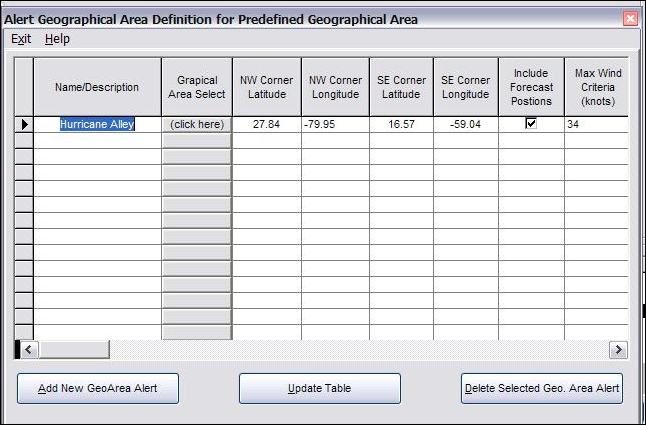
Click here to find out more about this dialog box
To add additional
areas, select the Add New Geo/Area and answer the questions on the setup “wizard”.
If you select multiple areas for the Geographical Alert, an separate email
will be sent for each one to each Email address you defined (assuming the trigger
has been met for the area). i.e. if you have
5 areas defined but only 1 is expected to have an active storm in it, then only 1
Email will be sent. Note:
There is absolutely no problem with defining only one area per Geographical
Alert.. It may, in fact, simplify things a bit.
For “more
expert” users, we have come up with the ability to send Email alerts based on
the timing of a trigger wind speed… in an escalating manner.
Let look at
an example and then explain how it will behave.
The image below
shows a location alert, with 5 entries for Miami.
Each one has the same wind speed criteria (34 knots) but the timing for these
winds vary for each entry.
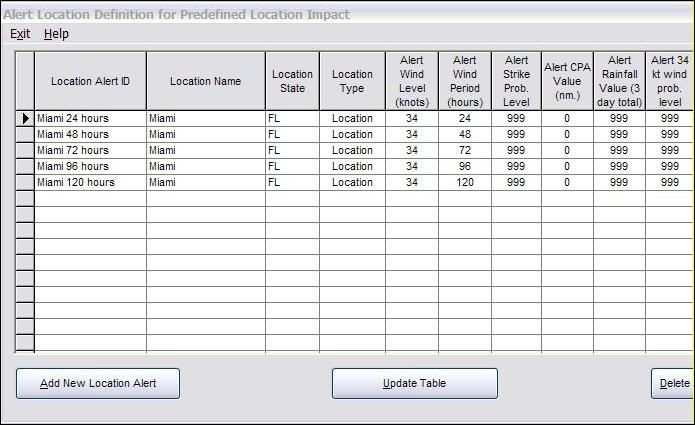
As a storm
is forecasted to impact Miami, initially the longest period alert will be sent (120
hours). As the storm approaches, the lower
period alerts will be sent instead… i.e. in this example, 96, 72, 48 and 24
hours.
One last thing
has to be set for this to work properly. One
the main Email Alert setup screen, you must select the option “Only send the
Alert with the lowest ‘wind period”.

This is a special
situation that most users will not necessarily require.
One
last topic in this section…. Error Assistance…
The Email Alert
Setup dialog is designed to help you along the way.
It does this by highlighting areas that need correcting as well as changing
the color of the border. So far all of the
examples above show a nice green border… which means “all is well”.
Let’s look at conditions which will cause errors and how they are demonstrated.
The image below
actually shows 2 errors… First no storm basin is selected, next… there
are no storms selected (the Selected Storms option is on).
Correcting each of these will turn the border green (assuming you have no
other errors).

The image below shows the important error of not having selected at least 1 email
address to send to.

For the Location alert you can also have
an error condition if no locations have been defined.

For the Location
Group alert, you must define the Location Group

For the Geographical
Area Alert, you need to define at least 1 area.

And finally,
similar to the Summary Report setup there is also a “WARNING” type error
conditions. A yellow border will appear if
the report is defined correctly but either the ACTIVE or AUTOMATION boxes are not
checked. This is acceptable under certain
conditions.
Remember, an ALL GREEN border means you have defined a “proper” Email Alert. Of course, this Alert will only be created when the storm and trigger settings are satisfied.